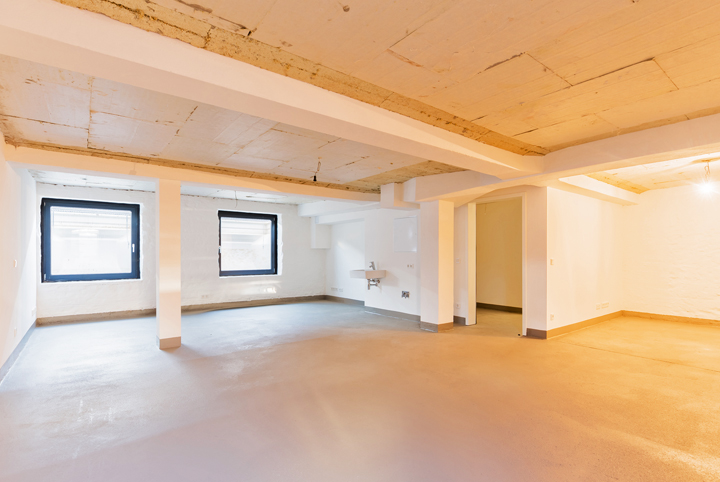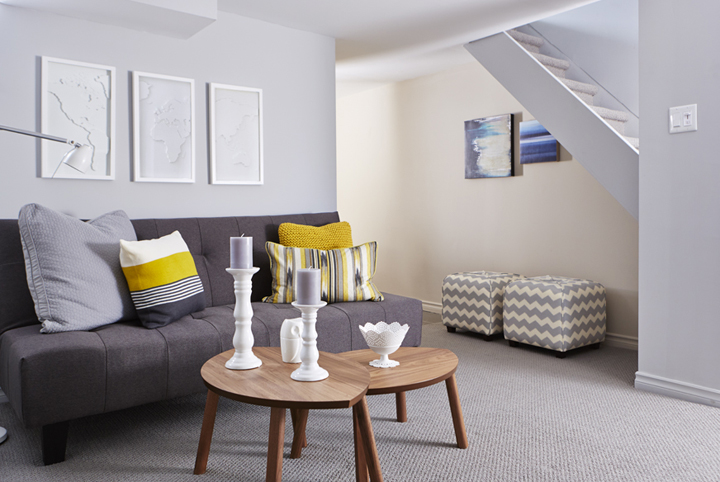
Brian McCourt is a contractor, design expert and co-host of HGTV Canada’s Backyard Builds.
A basement can reveal all sorts of deal breakers for potential buyers, from foundation cracks and musty smells to code-breaking utility installations and improper wall supports. Problems like these could send your visitors running out the door instead of running a credit application. But finishing a basement is no minor task. There are many moving parts, as it’s the most unstable level in a home thanks to humidity and moisture.
With that in mind, renovating a basement is about more than just the flow and style – it’s also about the foundation, the furnace, the flooring and the function of the rest of the house. So how do you flip a basement without compromising safety and still stay on budget? Read on.
1. Look for Signs of Moisture
The last thing you want to do is finish a basement during winter and have it flood come spring. Thoroughly inspect the space for cracks and signs of moisture before renovating.
2. Plan an Open Layout
Since you don’t know who your client will be while renovating a flip, leave many possibilities open when it comes to the overall use of the space. Don’t overthink the layout; just finish the outside walls and keep it open concept. After all, this is an “anything space”.

Photo courtesy of Getty Images
3. Seal Exterior Pest Points of Entry
Roommates who eat leftover food crumbs and then poop in your walls are the worst kind. Evict the rodents by sealing any exterior points of entry. Rodents and insects are probably one of the top turn-offs for potential buyers.
4. Incorporate a Storage Room
Most people love a generously sized basement storage room. The bonus of incorporating one is that it doesn’t need to be finished like the rest of the basement, which means it will save you money on your finishing costs. Build simple storage racks made from 2x4s and 3/4 inch plywood. This will cost a few hundred dollars, but it will be extremely well-received by prospective buyers.
More Flipping Tips: How to Update Your Bathroom For Big Returns
5. Respect the Budget
Paint might be the best option on a low-budget flip, especially when dealing with something like a dated wood-panelled basement that didn’t flag major issues on the home inspection. Once you open up the walls, there’s a chance you’ll uncover more than you bargained for and the possibility of going over budget dramatically increases. If you don’t have the budget to renovate extensively, then make it presentable for the interim until a future homeowner has the resources to do so.

6. Take Photos of Unseen Upgrades
If you invest in upgrades that are not clearly visible (like waterproofing, subfloors and premium insulation) take process photos and educate your real estate agent so he or she can inform interested buyers.
7. Disguise Bulkheads
One of the toughest aspects of a basement design is disguising all of the mechanical components that feed the rest of the house. We’ve all spent time cursing unsightly bulkheads, and while they are necessary, planning around them can be a bit of an art form. Try to bury as many as you can within the walls and ceilings, but make sense of the bulkheads you create by extending them wall-to-wall instead of building awkward boxes.
8. Choose Flooring Carefully
The reason we virtually never see real hardwood in basements is because of the unstable humidity levels that expand and contract wood products beyond their engineered capacity. That’s why laminate is a popular choice (not to mention its lower price point and easy installation). Wall-to-wall carpeting is the first thing I remove in a renovation – except in basements. I actually prefer a nice plush carpet in the basement because it makes the space cozy.

9. Light Right
Pot lights are a popular choice in basements thanks to their low-profile design, which pairs nicely with low ceilings. Unfortunately, they can cost a pretty penny. When the budget doesn’t allow for pot lights, opt for track lighting. Alternatively, installing two ceiling lights equal distance apart feels more up-to-date than the traditional single light in the middle of the room.
More Flipping Tips: How to Remodel Your Kitchen Like a Pro
10. Add Rough-ins for Income Suite
The cost of a basement renovation can climb quickly, which makes it hard to include an income suite in the budget. But if you’re already plumbing for a basement washroom, consider having rough-ins installed for a kitchen as well. This is a huge selling feature for some people and gives them a head start on a future income suite without coming at a huge cost to you.
Bonus Tip: Get a Home Inspection
We hear this tip often, but it’s arguably the most important one of them all: Get an extensive home inspection before you buy the property. Don’t automatically choose your realtor’s recommendation, as they may choose a less thorough inspector in order to sell the home. This inspection will be your renovation bible and will ensure the home scores an A+ when it’s inspected again by the new buyers.
Main feature image courtesy of Janis Nicolay
HGTV your inbox.
By clicking "SIGN UP” you agree to receive emails from HGTV and accept Corus' Terms of Use and Corus' Privacy Policy.



